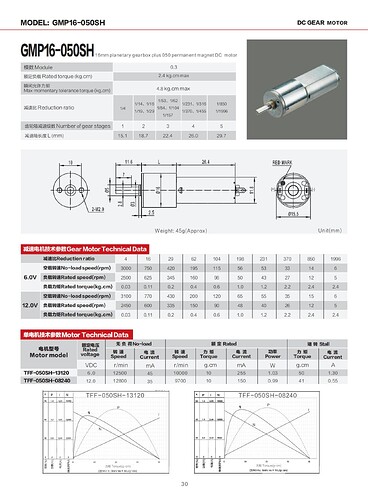Hi Mike, thank you for this summery.
It looks like the 2. league, the 1vs1 lightweight is sorted out and we could see these rule changes as settled. So we have to talk about the entry (former standard) league.
I would like to start the discussion about the motors.
I think a real “whitelist” is hardly possible for worldwide use as there are similar motors or even same motors with different brands. And to make it harder there are motors looking the same with completely different specs.
On of the resellers with a large variate of available motors is Pololu, but I am not sure if they possibly do buy there motors in China and the Asian market hat the same motors with just other names or product numbers.
So I would like to establish a rule that can be checked by easy measurement.
as rotations per minute and torque can be interchanged just by gear ratio the measurement of the consumed power sounds much more reasonable to me.
As we plan to reduce the maximum Voltage to 9V or practically 2S Lipo, that is slightly more then 8V with fully charged batteries, we can assume that all teams will have this very voltage for their motors.
So testing the stall power is easily measured by the stall current.
We had a 12V-2A power limit per motor at the former 1vs1 open rules in Germany (? or elsewhere) to avoid these wonderfull Pololu 25D12VHP motors with their 5A stall current consuming 60Watt per Motor.
The 12V-2A rule lead to a motor that fitted perfectly, and this is the Pololu 25D12VMP motor.
Combined with a 9.7:1 gear this motor is probably the most used motor in Germans soccer 1vs1 and as far as I could see the other European teams use this motor as well.
This is the link: Pololu - 9.7:1 Metal Gearmotor 25Dx48L mm MP 12V
So this motors are lying around in classrooms and garages already.
And they are affordable and very robust.
So why am I talking about this very motor?
Well, using this motor with only 8V will bring the stall current down to 1.2A
and this will reduce the maximum power to 10W.
This is roughly the power of large Lego Motors as far as I know.
The great advantage of allowing this type of motors is that they can be (re-) used for the next league as well, as they have have more than double the power at 12V. And this is probably a great sign of sustainability.
So my suggestion is not a whitelist but a stall current limit.
Make it 1.2A, 1.3A or even 1.5A to make sure there is no surprisingly superior motor within one series.
If a robot behave as expected, the motor datasheet should be fine. And if a robot looks far to powerful, referees should be allowed to measure the stall current at 8V.
If teams know that this could happen, they can be told to be prepared for it and have the ability to unplug the motor and plug it into a testing circuit of the referees. (That is a 2S Lipo and a multi-meter)
(Where “plugging” means connect cables per hand)
Consider this: we are not talking about hundreds of tests but only a few at the whole tournament, if at all.
If we use this current-limitation of 1.2A (or slightly more) we allow a large variety of other motors
but exclude the high current monsters you could get as well.
(like the Pololu - 9.7:1 Metal Gearmotor 25Dx48L mm HP 6V that hat 6A at 6V and 8A at 8V stall current consuming 64W)
We could find any other limit, but my main reason for the 1.2A is the usability of the widely spread 25D12VMP motors of pololu and alike.
What do you think?

